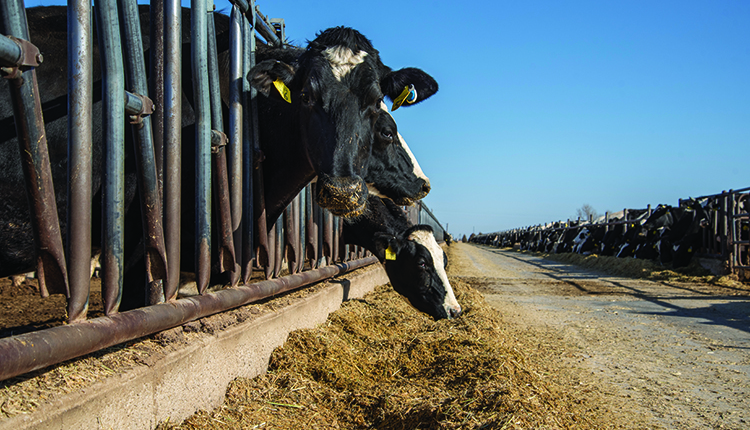The author is the founder of DNMCmilk, which works with dairy producers and heifer growers in several regions of the U.S. and around the world.

We live at a time where memes — amusing or interesting photos or videos that are shared online — communicate sentiments in a new way. In a world with pandemics, an ever-growing political divide, military conflict, and varying levels of climate concern, there is no shortage of sentiments that need to be communicated!
To make a point about the public’s opinion regarding COVID-19, one meme noted that Santa had been reading your social media posts and he will be getting you a science textbook for Christmas. Regular folks can’t simply develop the right pandemic policy or interpret climate change. For most, the meme hits close to home. In a world where almost anyone can know a little bit about nearly any topic, it is crucial that the court of public opinion be guided by those with more than a “little bit” of knowledge on such topics.
A classroom approach
Much of my work with feeding dairy cows can be understood with the basics of fifth grade math and ninth grade science. I may not be right on the exact school years, but the point is that there are basic laws of science and math that can correctly answer the questions we face in what seems to be a new world. Every industry is being asked or required to do better in numerous areas related to efficiency, sustainability, and using natural resources.
It is true that farmers are not new to the environmental movement. To be candid, agriculture has been far from perfect in the quest to work “along with,” instead of “against,” nature. Our history is not without a few black eyes along the way, but what industry doesn’t have a similar learning curve?
In response to the obvious problems related to plowing up the arid High Plains to plant wheat in the 1930s and the resulting Dust Bowl era, the Soil Conservation Service was created to leverage science and logic into better practices for farmers. Of course, this didn’t solve every problem, and the learning curve continues with ever-improving science and technology to reach new levels of environmental care.
Progress has been made
Many of the principles that define success or failure in this race to be sustainable can be described by the classroom science and math mentioned above. The math presides over the dollars and cents of products purchased and products sold. The science presides over the unique task of utilizing the connection between animals and the land used to feed people.
There has been a noticeable uptick in the frequency of conversations with my clients about topics related to sustainability. Among these conversations are discussions about manure digesters, solar panels, electric feed delivery trucks, drought-tolerant forage crops, and numerous feed additives that reduce greenhouse gases. It is a lot to consider.
The opportunities related to improving efficiency of converting feed to human food is our firm’s area of expertise. It’s the upcycling of one set of nutrients into another set of nutrients. One set is mostly unusable by humans; the second set is high-quality human food ready to ship anywhere in the world.
These worldwide customers are speaking out more often and with greater volume about their interest in how food is produced. I think going back to the fifth grade math, and especially the ninth grade science, is the path to satisfying the financial needs of those whose life’s work is milking cows and the dairy product consumers.
If you look at what consumers want, the dairy industry has made much progress already. Every efficiency one could measure is better now than even 20 years ago. This is not only good for the producer searching for a reasonable margin to feed their own families, but it’s also good for so many concerns related to sustainability and climate change.
The next gains will be more difficult to achieve and will likely put pressure on producer margins. Will the consumer be willing to pay a higher cost to help the farmer maintain respectable margins?
Efficiency is the goal
We are sitting on the cusp of a sea of change in this conversation. We are working with several potential feed additives that can make a significant reduction in methane production. And guess what — they also improve milk production efficiency and producer margins.
Going all the way back to nutrition class as a freshman in college, we were taught the role of methane in a cow’s rumen; this is not a new topic for our industry. We have been working for a generation now to find the best way to reduce this loss of carbon.
The Food and Drug Administration’s approval of monensin in dairy rations in 2004 offered the first tool for our industry to reduce methane. This technology had been utilized in beef production prior to that time and it is employed significantly in dairy and beef production today. What is next in this arena?
My challenge to our industry is to listen to consumers and engage with science to become even more efficient in producing milk and beef. Furthermore, our goal should be to expand the portion of beef and dairy cattle diets that is made up of ingredients unusable by humans. A falling trend over time for primary grains like corn in dairy rations will help us meet our goals.
In order to accomplish that and still meet the need for adequate margins, the nutritional science advancements for improving milk production efficiency with lower quality forages, human food by-product streams, and even animal genetics and husbandry will all work hand in hand. This will sustain our industry for generations to come.
This article appeared in the February 2023 issue of Journal of Nutrient Management on pages 14-15. Not a subscriber? Click to get the print magazine.





